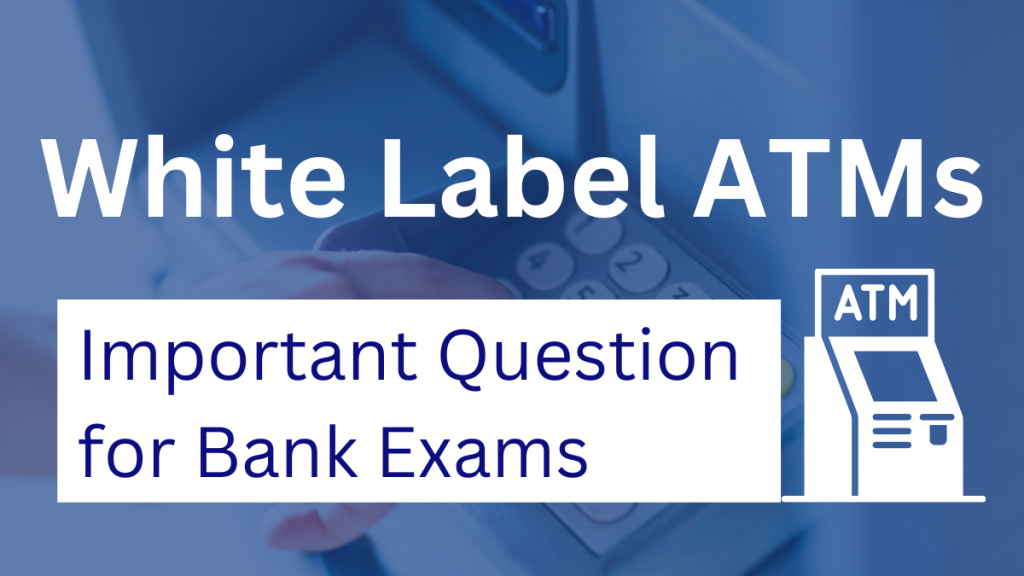White Label ATMs (WLAs) have played a pivotal role in extending the reach of automated banking services in India. Before 2012, only banks held the authority to establish Automated Teller Machines (ATMs), resulting in constrained growth, particularly in Tier I and Tier II cities. Acknowledging the potential for enhanced financial inclusion, the Reserve Bank of India (RBI) introduced White Label ATMs, permitting non-bank entities to set up and manage ATMs nationwide.
The RBI Grade B exam emphasizes a comprehensive understanding of concepts over rote memorization. Recognizing that memorization can lead to forgetfulness and frustration, effective preparation for the RBI Grade B exam requires a focus on comprehension and clarity. This ixamBee blog series is a valuable resource, facilitating a deep understanding of topics and ensuring candidates can confidently respond to any related questions on exam day.

By allowing non-bank entities to operate ATMs, WLAs have significantly contributed to extending banking services to previously underserved areas. This move aligns with the broader objective of promoting financial inclusivity across diverse regions of the country. As candidates prepare for the RBI Grade B exam, a thorough grasp of topics, such as White Label ATMs, is essential for success, and this article serves as a reliable guide in achieving this goal.
Introduction to White Label ATMs
White Label ATMs (WLAs) represent a distinctive facet of the banking landscape, characterized by their absence of specific bank branding. Operated by non-bank entities designated as White Label ATM Operators (WLAOs), these ATMs have transformed the traditional banking paradigm. For a non-bank entity to become a WLAO, adherence to the regulatory framework is imperative, including the requirement to be incorporated in India under the Companies Act of 1956. The genesis of White Label ATMs dates back to the imperative need for an expansive and inclusive banking infrastructure. Before their introduction, the deployment of Automated Teller Machines (ATMs) was restricted to banks, resulting in a limited presence, predominantly in Tier I and Tier II cities. The Reserve Bank of India (RBI), recognizing the potential for financial inclusion, introduced the concept of WLAs, enabling non-bank entities to own and operate ATMs across the country.
The primary objective of WLAs is to catalyze the proliferation of ATMs in Tier III to Tier VI cities, where banking services were historically less accessible. By doing so, WLAs bridge the geographical gap, empowering a broader spectrum of the population with convenient and reliable banking services. This move aligns with the broader national agenda of fostering financial inclusion and ensuring that the benefits of modern banking reach every corner of the country. White Label ATMs embody a paradigm shift in the banking ecosystem, democratizing access to financial services and redefining the contours of convenience in banking for diverse communities. As non-bank entities continue to contribute to this innovative landscape, the impact of White Label ATMs resonates as a testament to the evolution and inclusivity in India’s banking sector.
Regulatory Framework for White Label ATMs
White Label ATM Operators (WLAOs) face stringent regulatory requirements outlined by the Reserve Bank of India (RBI) under the Payment and Settlement Systems (PSS) Act of 2007. To establish and operate White Label ATMs (WLAs), WLAOs must obtain explicit authorization from the RBI, ensuring compliance with the regulatory framework.
Financial robustness is a key criterion for WLAOs, mandating a minimum net worth of Rs. 100 crore as per the audited balance sheet of the latest financial year. This financial prerequisite underscores the importance of stability and solvency for entities engaging in the operation of WLAs.
To foster equitable distribution of banking infrastructure, the RBI has instituted measures to prevent concentration in Tier I and Tier II cities. Specific guidelines dictate the ratio of WLAs to be set up in Tier III to VI centers concerning each WLA installed in Tier I to II centers. The ratio, predetermined at the time of registration, could be 3:1, 2:1, or 1:1 based on the scheme selected by the WLAO. The regulatory framework prohibits switching between schemes and imposes restrictions on the takeover of ATMs operated by banks, thereby ensuring a strategic and balanced expansion of White Label ATMs across different tiers of cities in India.
Services Provided by White-Label ATMs:
A strategic expansion of services has marked the evolution of White Label ATMs (WLAs) in India, transforming these entities beyond cash withdrawal points. Initially limited to basic services like cash withdrawal, WLAs underwent a significant transformation in March 2019 when the Reserve Bank of India (RBI) introduced revised guidelines, expanding their scope of operations.
Under the updated guidelines, WLAs gained the authority to offer advanced services, including cash deposit and bill payment services. This progressive step was contingent upon the technical feasibility of the devices employed, a determination made by the National Payments Corporation of India (NPCI). This enhancement in the range of services not only elevated the utility of WLAs but also aligned them with consumers’ changing needs and expectations.
Cash deposit services introduced through WLAs contribute to users’ convenience, providing a comprehensive suite of banking functionalities beyond simple cash withdrawals. Additionally, incorporating bill payment services further positions WLAs as versatile financial service points, enabling users to settle their bills seamlessly.
Furthermore, another pivotal aspect of the revised guidelines is the allowance for WLAs to display advertisements of non-finance products. This strategic move is accompanied by a crucial stipulation – the advertisements should not disrupt the customer’s transaction process. This balance ensures that the customer experience remains seamless and uninterrupted.
The decision to permit advertisements on WLAs not only adds a new dimension to the services offered but also presents a lucrative avenue for revenue generation. By showcasing non-finance products, operators of WLAs can diversify their income streams, creating a sustainable business model that extends beyond traditional transaction fees.
In essence, the expanded scope of services for WLAs, encompassing cash deposit, bill payments, and non-finance product advertisements, reflects a forward-looking approach by regulatory authorities. It positions WLAs as dynamic entities capable of addressing diverse customer needs while concurrently offering operators opportunities for revenue diversification and sustained growth in the ever-evolving landscape of financial services.
Cash Sourcing and Advertisement Displays
he operational landscape of White Label ATM Operators (WLAOs) in India witnessed a notable shift with revised guidelines addressing cash sourcing for their Automated Teller Machines (ATMs). Initially reliant on sponsor banks for cash infusion, the updated directives now empower WLAOs with greater flexibility in managing their cash logistics.
Under the revised framework, WLAOs can source cash directly from various channels, including RBI offices, currency chests, and any scheduled bank, encompassing Cooperative Banks and Regional Rural Banks. This diversification in cash sourcing reduces dependence on a single channel and grants WLAOs autonomy in optimizing their cash management strategies, ensuring efficiency and reliability in their ATM operations.
In tandem with this shift, the permission granted to display advertisements on White Label ATMs presents an innovative avenue for revenue generation. WLAOs can leverage this opportunity to showcase non-finance products on the ATM screens. Importantly, the guidelines emphasize that these advertisements should not disrupt the customer’s transaction experience, ensuring a seamless and uninterrupted banking interaction. This dual-pronged approach – diversified cash sourcing and non-finance product advertisements – enhances the revenue potential for WLAOs, fostering a sustainable and dynamic business model in the realm of automated banking services.
Key White Label ATM Operators in India:
As of July 20, 2019, seven White Label ATM operators are actively registered and operating in India, contributing to the expansive reach of banking services. Notable operators include Tata Communications Payment Solutions Ltd. with their brand Indicash (licensed since 3 May 2013) and Hitachi Payment Services Pvt. Ltd. operating under the brand Hitachi Money Spot (licensed since 25 Nov 2013). It is important to mention that SREI Infrastructure Finance Ltd. ceased its WLA operations in April 2019 (licensed since 25 Mar 2014). The table provides a snapshot of White Label ATM Operators (WLAOs) in India, showcasing their brand names and licensing dates. For further information, it’s important to note that SREI Infrastructure Finance Ltd. discontinued its WLA operations since April 2019, indicating a shift in the industry landscape.
| White Label ATM Operator | Brand Name | Licensed Since |
| Tata Communications Payment Solutions Ltd. | Indicash | 3 May 2013 |
| Hitachi Payment Services Pvt. Ltd. | Hitachi Money Spot | 25 November 2013 |
| Vakrangee Limited | Vakrangee Kendra ATM | 23 Jan 2014 |
| Muthoot Finance Ltd. | Muthoot ATM | 30 Jan 2014 |
| BTI Payments Pvt. Ltd | India1 ATM | 12 Feb 2014 |
| RiddiSiddhi Bullions Limited | State ATM | 15 May 2014 |
| AGS Transact Technologies Ltd. | OnGo | 30 Jun 2014 |
| SREI Infrastructure Finance Ltd. | Discontinued since April 2019 | 25 Mar 2014 |
Exploring additional details about each operator could involve delving into their operational footprint, the extent of services offered, and any notable contributions to the advancement of White Label ATMs in India. While the table presents a concise overview, a more comprehensive analysis could provide deeper insights into the individual strategies, innovations, and challenges each WLAO faces in contributing to the financial inclusion goals set by the Reserve Bank of India.
Prepping for RBI Grade B with ixamBee
ixamBee is an invaluable resource for RBI exam aspirants, offering RBI Grade B Free Mock Tests that mirror actual RBI Grade B Exam Pattern and Syllabus, aiding in understanding question types and time management. Access to RBI Grade B Previous Year Papers helps candidates analyze historical trends for strategic preparation. Expert-curated RBI Grade B Online Courses cover the syllabus comprehensively, ensuring a well-rounded understanding. BeePedia, focusing on General Awareness, enhances preparation. The RBI presents diverse career opportunities through roles other than RBI Grade B, like RBI Grade A Rajbhasha, RBI Assistant, RBI Office Attendant, RBI Grade B DEPR, RBI Grade B Legal, and RBI Non-CSG, offering promising careers and contributing to India’s financial progress. With its rich history, the Reserve Bank of India plays a pivotal role in shaping the nation’s economic landscape.
Summing Up
White Label ATMs have emerged as a crucial component in India’s journey toward financial inclusion. By allowing non-bank entities to establish and operate ATMs, the RBI has fostered the growth of banking services in previously underserved areas. The flexibility in services offered, cash sourcing, and advertisement displays ensures that WLAs can adapt to the evolving needs of customers and operators alike. As the financial landscape continues to evolve, the role of White Label ATMs is likely to become even more prominent in bridging the gap between traditional banking and the unbanked population.
About the Author Prachi Agarwal:

Prachi Agarwal is an MBA (Finance) from BIMTECH, Noida and B. Com (Hons) from Hansraj College, Delhi University. She has previously worked with CARE Ratings. At ixamBee, she is faculty for Financial and Management and Securities Market Awareness. Her expertise topics are Ratio analysis, risk management, bond valuation, etc. She is the student’s favorite faculty for her easy to understand approach while teaching in Live Classes.
To help you prepare 50% faster for competitive exams, ixamBee provides a free Mock Test Series and all the Current Affairs in English and Current Affairs in Hindi in the BeePedia capsules for GA Preparation. You can also get the latest updates for Bank PO, Bank Clerk, SSC, RBI Grade B, NABARD, and Other Government Jobs.
Also Read
FDI, FPI and FII: All the Details to Know
Understanding the Reserve Bank of India Act 1934
RBI Bans Paytm Payments Bank – Will Paytm Karo Be No More?













